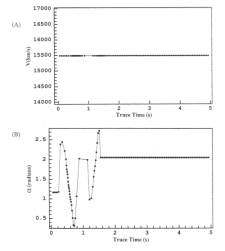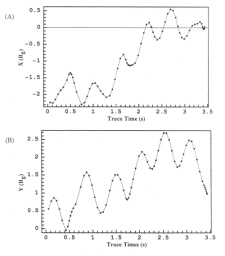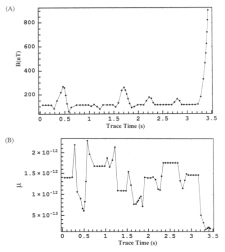Investigation of the Magnetosphere of Ganymede with Galileo's Energetic Particle Detector
Ph.D. dissertation by Shawn M. Stone, University of Kansas,
1999.
Copyright 1999 by Shawn M. Stone. Used with permission.
6.2.1 Ion Results (continued)
Figures 6.26 through 6.31 present the results for subenergy 1110 keV sublook 5 for channel A6 which are summarized in Table 6.3. An inspection of the magnetic field experienced by the particle, Figure 6.28a, shows a dip toward zero field at .9 s of trace time. Figures 6.26 and 6.27 show that the particle translates instead of gyrates at this time for a period of about 1 s, then is recaptured and begins gyrating again. Figure 6.28b, the magnetic moment plot, shows two boundary crossings taking place at a trace time of .2 s and 1.2 s. This is the reason for the shift in µ value. Figure 6.29a shows that the energy of the particle was conserved despite these transitions. Figure 6.29b shows the corresponding pitch angle, where the transitions across the boundary and through the null point can be seen. This motion is illustrated in the XZ (Figure 6.30) and YZ (Figure 6.31) projections of the trajectory.
Table 6.3 Summary of Figures 6.26 through 6.31 for subenergy 1110 keV sublook direction 5 for model M2 channel A6.
| Figure | Information | Observation |
| 6.26 | (A) Radius of particle from Ganymede. (B) Z component of particle trajectory. | A null point slip can be seen at a trace time of about 1 s. |
| 6.27 | (A) X component of particle trajectory. (B) Y component of particle trajectory. | A null point slip can be seen at a trace time of about 1 s. |
| 6.28 | (A) Magnetic field sampled by the particle. (B) Magnetic moment sampled by the particle. | A null point in the B field can be seen at 1 s. The magnetic moment spikes at this time. Shifts in the magnetic moment correspond to regions within and external to the magnetosphere of Ganymede. |
| 6.29 | (A) speed of the particle as it moves through its trajectory. (B) Pitch angle of the particle. | The speed of the particle is constant even though the motion is non-adiabatic at the null point. The pitch angle shows that the particle reaches a bounce point, moves through a null at 1 s, and bounces through the boundary and out. |
| 6.30 | ZX projection of the trajectory of the particle. | When the particle is in a region of nominal field, the motion is translational. This particular trajectory bounces out of the magnetosphere of Ganymede. |
| 6.31 | ZY projection of the trajectory of the particle. | When the particle is in a region of nominal field, the motion is translational. This particular trajectory bounces out of the magnetosphere of Ganymede. |
 |
Figure 6.26 (A) Length of the radius vector from the center of Ganymede to the particle as a function of trace time in seconds for subenergy 1110 keV sublook direction 5 for model 2 channel A6. Ten points comprise a gyroperiod. (B) The Z component of the particle position in GSII coordinates for subenergy 1110 keV sublook direction 5 for model 2 channel A6. |
 |
Figure 6.27 (A) The X component of the particle position in GSII coordinates for subenergy 1110 keV sublook direction 5 for model 2 channel A6. (B) The Y component of the particle position in GSII coordinates for subenergy 1110 keV sublook direction 5 for model 2 channel A6. |
 |
Figure 6.28 (A) Magnetic field at the location of the particle as a function of trace time for subenergy 1110 keV sublook direction 5 for model 2 channel A6. (B) Magnetic moment at the location of the particle as a function of trace time for subenergy 1110 keV sublook direction 5 for model 2 channel A6. |
 |
Figure 6.29 (A) Velocity of the particle as a function of trace time for subenergy 1110 keV sublook direction 5 for model 2 channel A6. (B) Pitch angle of the particle as a function of trace time for subenergy 1110 keV sublook direction 5 for model 2 channel A6. |
 |
Figure 6.30 ZX projection of the trajectory for subenergy 1110 keV sublook direction 5 for model 2 channel A6. |
 |
Figure 6.31 ZY projection of the trajectory for subenergy 1110 keV sublook direction 5 for model 2 channel A6. |
Figures 6.32 through 6.37 present the results for subenergy 1110 keV sublook 7 for channel A6, summarized in Table 6.4. There is a small interaction with a null point shown by the magnetic field plot Figure 6.34b at about .6 s.
Table 6.4 Summary of Figures 6.32 through 6.37 for subenergy 1110 keV sublook direction 7 for model M2 channel A6.
| Figure | Information | Observation |
| 6.32 | (A) Radius of particle from Ganymede. (B) Z component of particle trajectory. | A null point slip can be seen at a trace time of about .6 s. |
| 6.33 | (A) X component of particle trajectory. (B) Y component of particle trajectory. | A null point slip can be seen at a trace time of about .6 s. |
| 6.34 | (A) Magnetic field sampled by the particle. (B) Magnetic moment sampled by the particle. | A null point in the B field can be seen at .6 s. The magnetic moment spikes at this time. At times later than this an inspection of B and m shows that the particle skirts the boundary. |
| 6.35 | (A) Speed of the particle. (B) Pitch angle of the particle. | The speed of the particle is constant even though the motion is non-adiabatic at the null point. The pitch angle shows the regions outside the boundary (constant) and inside the magnetosphere (varying). |
| 6.36 | ZX projection of the trajectory of the particle. | When the particle is in a region of nominal field, the motion is translational. This particular trajectory bounce impacts Ganymede. |
| 6.37 | ZY projection of the trajectory of the particle. | When the particle is in a region of nominal field, the motion is translational. This particular trajectory bounce impacts Ganymede. |
 |
Figure 6.32 (A) Length of the radius vector from the center of Ganymede to the particle as a function of trace time in seconds for subenergy 1110 keV sublook direction 7 for model 2 channel A6. Ten points comprise a gyroperiod. (B) The Z component of the particle position in GSII coordinates for subenergy 1110 keV sublook direction 7 for model 2 channel A6. |
 |
Figure 6.33 (A) The X component of the particle position in GSII coordinates for subenergy 1110 keV sublook direction 7 for model 2 channel A6. (B) The Y component of the particle position in GSII coordinates for subenergy 1110 keV sublook direction 7 for model 2 channel A6. |
 |
Figure 6.34 (A) Magnetic field at the location of the particle as a function of trace time for subenergy 1110 keV sublook direction 7 for model 2 channel A6. (B) Magnetic moment at the location of the particle as a function of trace time for subenergy 1110 keV sublook direction 7 for model 2 channel A6. |
 |
Figure 6.35 (A) Velocity of the particle as a function of trace time for subenergy 1110 keV sublook direction 7 for model 2 channel A6. (B) Pitch angle of the particle as a function of trace time for subenergy 1110 keV sublook direction 7 for model 2 channel A6. |
 |
Figure 6.36 ZX projection of the trajectory for subenergy 1110 keV sublook direction 7 for model 2 channel A6. |
 |
Figure 6.37 ZY projection of the trajectory for subenergy 1110 keV sublook direction 7 for model 2 channel A6. |
Although there were many more null point interactions than could be presented here, Table 6.5 lists some of the more interesting ones and their findings for model M1 and M2; the plots can be found in Appendix C. The features not explicitly shown can be graphed if needed by the interested reader from the CD in Appendix C. All ASCII tabulated data is labeled clearly, and a guide to construct all features in this work is contained in readme.txt.
Table 6.5 Summary of features of model M1 and M2 not included in the main body of the text. The corresponding graphs are presented in Appendix C. The precise graphs are indicated in the description column.
| Feature | Model | Description |
| G2-18:43:11 | M1 | Real data displays isotropic distribution for the electrons. Ions show evidence of convection. Model M1 begins to exhibit deviation from the measured pitch and phase. Simulated ions are showing null point interactions (A2, A4, and A6). Figures C.1 through C.5. |
| G2-18:43:11 | M2 | Real data displays isotropic distribution for the electrons. Ions show evidence of convection. Model M2 matches the measured pitch and phase. Simulated ions are showing null point interactions for channel A6. Figures C.6 through C.9. |
| G2-18:50:11 | M1 | Real data for channel A4 exhibits null point interactions and model M1 predicts one in the spin at about the depth seen. Figure C.10. |
| G2-18:50:11 | M2 | Real data for channel A4 exhibits null point interactions and model M2 predicts a similar structure in depth and shape shifted by about 6 s later. Figure C.11. |
| G2-18:50:31 | M1 | Real data for channel A4 shows a null point interaction. Model M1 shows a null point interaction near the observed, but it is broad and not abrupt. Figure C.12. |
| G2-18:50:31 | M2 | Real data for channel A4 shows a null point interaction almost matched by Model M2 in time and depth. See Figure C.13. |
| G2-18:50:31 | M2 | Real data for channel A2 shows a null point interaction almost matched by Model M2 in time and depth. See Figure C.14. |
Next: 6.2.2 Electron Results
Return to dissertation table of contents page.
Return to main
Galileo Table of Contents Page.
Return to Fundamental
Technologies Home Page.
Updated 8/23/19, Cameron Crane
QUICK FACTS
Mission Duration: Galileo was planned to have a mission duration of around 8 years, but was kept in operation for 13 years, 11 months, and 3 days, until it was destroyed in a controlled impact with Jupiter on September 21, 2003.
Destination: Galileo's destination was Jupiter and its moons, which it orbitted for 7 years, 9 months, and 13 days.



